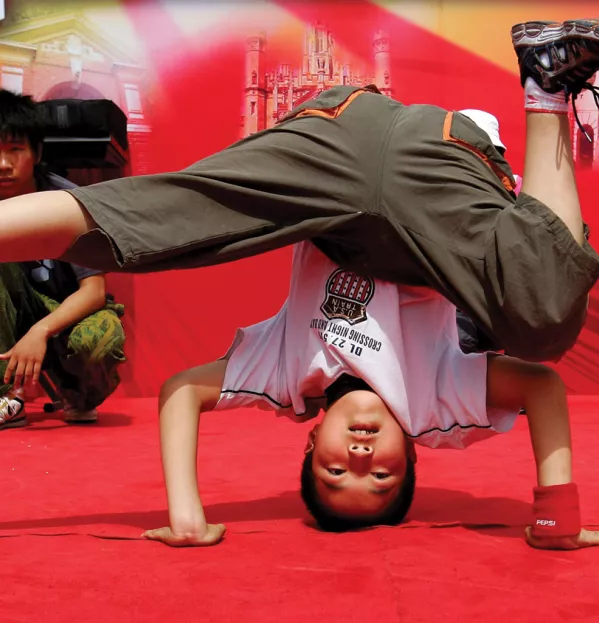
Rapping up Mandarin

If you want to get an insight into what your YouTube-fixated, viral-hungry students are looking at online this year, you won’t go far wrong if you spend some time with a few Asian hip hop artists. Be it the viral thrust and wry wit of Indonesia’s Rich Chigga, the America-breaking ferocity of South Korea’s Keith Ape or China’s hottest new hip hop property, Higher Brothers, this is one of the year’s most dominant, and credible, trending genres.
This rise of Asian hip hop comes at a fortuitous time for London teacher Adam Moorman. While his approach to teaching Mandarin to key stage 5 students at Fortismere School in North London was not inspired by his students’ preoccupation with the new stars of rap, it certainly feeds into it: he’s getting his class to rap in Mandarin themselves.
“It’s much easier than you think,” Moorman says. “Mandarin is a monosyllabic language with a much more limited range of sounds than English. If you discount tones, there are around 400 syllables in Mandarin, compared with more than 8,000 in English. So it’s a lot harder to come up with rhymes in English than in Mandarin.”
Musical language
Students are asked to create raps as preparation for their speaking exam. Guided on content by the key topics in the qualification (pollution, for example) and on complexity by the exam marking criteria, they write, practise and then perform the raps, which are recorded. Moorman explains that rap is a useful tool to get students talking for a number of reasons. First, he says that Mandarin is an inherently musical language, so it lends itself to the genre. Second, learning a language requires repetition, and keeping that engaging is tough - writing and performing a rap gives students a compelling reason to go over sentences again and again. Third, the nature of rap means that dexterity of vocabulary is rewarded - so there is an incentive to learn more phrases and be innovative with them.
“Many teachers find that, as students move through KS4-5, they become frustrated by the difficulty of constructing longer passages of speech,” Moorman explains. “Some of the fun, freshness and simplicity of language-learning at KS3 disappears.
“This approach tackles that by combining rhythm, rhymes and repetition in an enjoyable and memorable way that shifts the focus from painstaking book-based learning, but achieves the rewards of independent research, drafting and practising.”
But have the students really taken to it? “The initial reaction has been very positive, even with shy students. By having time to prepare, many chances to record and the option to work in groups, all are able to participate,” Moorman explains, adding that all the expected benefits outlined above have been evident in his classes.
So far, Moorman has run this as a pilot in his own school, but 40 teachers responded to his offer to share the KS5 resources on the UK Mandarin teachers’ forum. He also recently won funding from the London Teacher Innovation Fund, which is financed by the mayor of London and run by education charity Shine, to expand the project and create resources that will be accessible to all schools in the UK from July 2017.
The full resource package will include instrumentals for other students to use - as luck would have it, Fortismere music teacher Niall Lavelle is the percussionist in festival favourites Gentleman’s Dub Club, enabling high production values - and a book of resources that will feature two raps per exam topic and guides on how students can write and perform their own.
Rhyme and reason
Can this successful model can be translated into other languages?
“I asked myself this straight away,” says Moorman, who also speaks Spanish, Portuguese and conversational French. “But it would be difficult because of the complex amount of sounds and phonetics. You’d have to speak the language at a much higher level. Mandarin lends itself to this way of learning in a unique and special way.”
And there is more than enough to be getting on with when it comes to Mandarin teaching - Moorman is pondering GCSE-level resources, and his work will feed into the £10 million Mandarin Excellence Programme run by the UCL Institute of Education, which aims to have 5,000 young people speaking fluent Mandarin by 2020. There is currently a dearth of resources for teachers, so his project will be much welcomed.
Of course, there will be criticisms about pandering to students’ interests rather than teaching the language to them straight, but Moorman doesn’t buy into that argument. He says hip hop is an art form that we should be utilising, and that approaching speaking in this way encourages creativity with language - often sorely missed at this level of teaching.
“The project aims to stimulate creativity,” Moorman stresses. “I do not expect every student to become a rapper, but it might provide inspiration for their own innovative uses of the language.”
For more on the Shine Awards and how to enter, click here. Adam Moorman can be contacted at amoorman@fortismere.org.uk
Dave Jenkins is a freelance writer and editor
You need a Tes subscription to read this article
Subscribe now to read this article and get other subscriber-only content:
- Unlimited access to all Tes magazine content
- Exclusive subscriber-only stories
- Award-winning email newsletters
- Unlimited access to all Tes magazine content
- Exclusive subscriber-only stories
- Award-winning email newsletters
You need a subscription to read this article
Subscribe now to read this article and get other subscriber-only content, including:
- Unlimited access to all Tes magazine content
- Exclusive subscriber-only stories
- Award-winning email newsletters
- Unlimited access to all Tes magazine content
- Exclusive subscriber-only stories
- Award-winning email newsletters